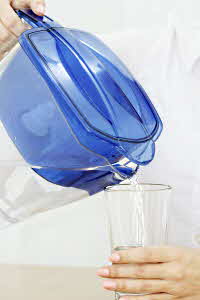Home | ARTICLES | Food_Trivia | Today_In_Food_History | Food_History_Timeline | Recipes | Cooking_Tips | Food_Videos | Food_Quotes | Who's_Who | Cooking Schools_&_Tours | Food_Trivia_Quizzes | Food_Poems | Free_Magazines | Food_Festivals_&_Events

You are here > Home > Food Articles >
CULINARY SCHOOLS &
COOKING CLASSES
From Amateur & Basic Cooking Classes to Professional Chef Training
Over 1,000 schools & classes listed for U.S., Online & Worldwide
FREE Food & Beverage Publications
An extensive selection of free magazines and other publications for qualified Food, Beverage & Hospitality professionals
SAFE CHLORINE LEVELS IN DRINKING WATER
Dear EarthTalk:
I was wondering how toxic chlorine is, because my well water was just chlorinated yesterday and today the smell is still strong. I have a 4-year-old daughter and I’m concerned.
Rose Smith, via e-mail
According to the U.S. Environmental Protection Agency (EPA), chlorine levels of four parts per million or below in drinking water—whether from a private well or municipal reservoir—are acceptable from a human health standpoint. Inexpensive home drinking water test kits (from $5 on up) that can detect levels of chlorine and other elements in water are widely available from online vendors. Administering the tests is easy and can provide parents with a way to involve kids in science for a practical purpose right at home.

The most affordable approach is to filter it at the faucet or with a pitcher-mounted filter.
Credit: iStockPhoto
Chlorine was first used in drinking water to reduce waterborne infectious diseases in Jersey City, New Jersey more than a century ago. It was so effective at destroying potentially harmful bacteria and viruses that the practice soon spread far and wide. Today some 98 percent of water treatment facilities in the U.S. use some form of chlorine to clean drinking water supplies. The American Water Works Association (AWWA), a trade group representing water utilities across the country, credits the presence of chlorine in drinking water with a 50 percent increase in life expectancy for Americans over the last century. Indeed, some consider the chlorination of drinking water to be one of history’s greatest public health achievements.
But others aren’t so sure that any chlorine in drinking water should be considered safe. Opponents of chlorination point to studies linking repeated exposure to trace amounts of chlorine in water with higher incidences of bladder, rectal and breast cancers. The problem lies in chlorine’s ability to interact with organic compounds in fresh water to create trihalomethanes (THMs), which when ingested can encourage the growth of free radicals that can destroy or damage vital cells in the body. Besides cancer, exposure to THMs has been linked to other health issues including asthma, eczema, heart disease and higher miscarriage and birth defect rates.
Those with their own private wells who are skittish about chlorine have other options for disinfecting their water. One baby step would be to replace chlorine with chloramine, an ammonia derivative that doesn’t dissipate into the environment as rapidly as chlorine and has a much lower tendency to interact in bad ways with organic compounds in the water. However, traces of chloramine in the water may not be to everyone’s liking either, because it causes rashes after showering in a small percentage of people and can apparently increase lead exposure in older homes as it leaches the heavy metal off old pipes.
Another option, though somewhat costly, would be to purchase a machine to purify the water. Ozonation units, which disinfect by adding ozone molecules to water and leave no residues, start at around $9,000. Another choice would be a UV light treatment machine—at $6,000 or more—which cancels out viruses and bacteria by passing the water through UV light rays. The Clean Water Store is a reputable vendor and good online source for such water treatment equipment.
Perhaps the most sensible and affordable approach is to filter the water at the faucets and taps. Carbon-based tap- or pitcher-mounted filters can work wonders in removing impurities from drinking water. They can even be installed on shower heads for those with sensitive skin.
CONTACTS: AWWA, www.awwa.org ; The Clean Water Store, www.cleanwaterstore.com
May 2013
EarthTalk® is written and edited by Roddy Scheer and Doug Moss and is a registered trademark of E - The Environmental Magazine (www.emagazine.com). Send questions to: earthtalk@emagazine.com Subscribe: www.emagazine.com/subscribe Free Trial Issue: www.emagazine.com/trial
RELATED ARTICLES
Please feel free to link to any pages of FoodReference.com from your website.
For permission to use any of this content please E-mail: james@foodreference.com
All contents are copyright © 1990 - 2024 James T. Ehler and www.FoodReference.com unless otherwise noted.
All rights reserved.
You may copy and use portions of this website for non-commercial, personal use only.
Any other use of these materials without prior written authorization is not very nice and violates the copyright.
Please take the time to request permission.
